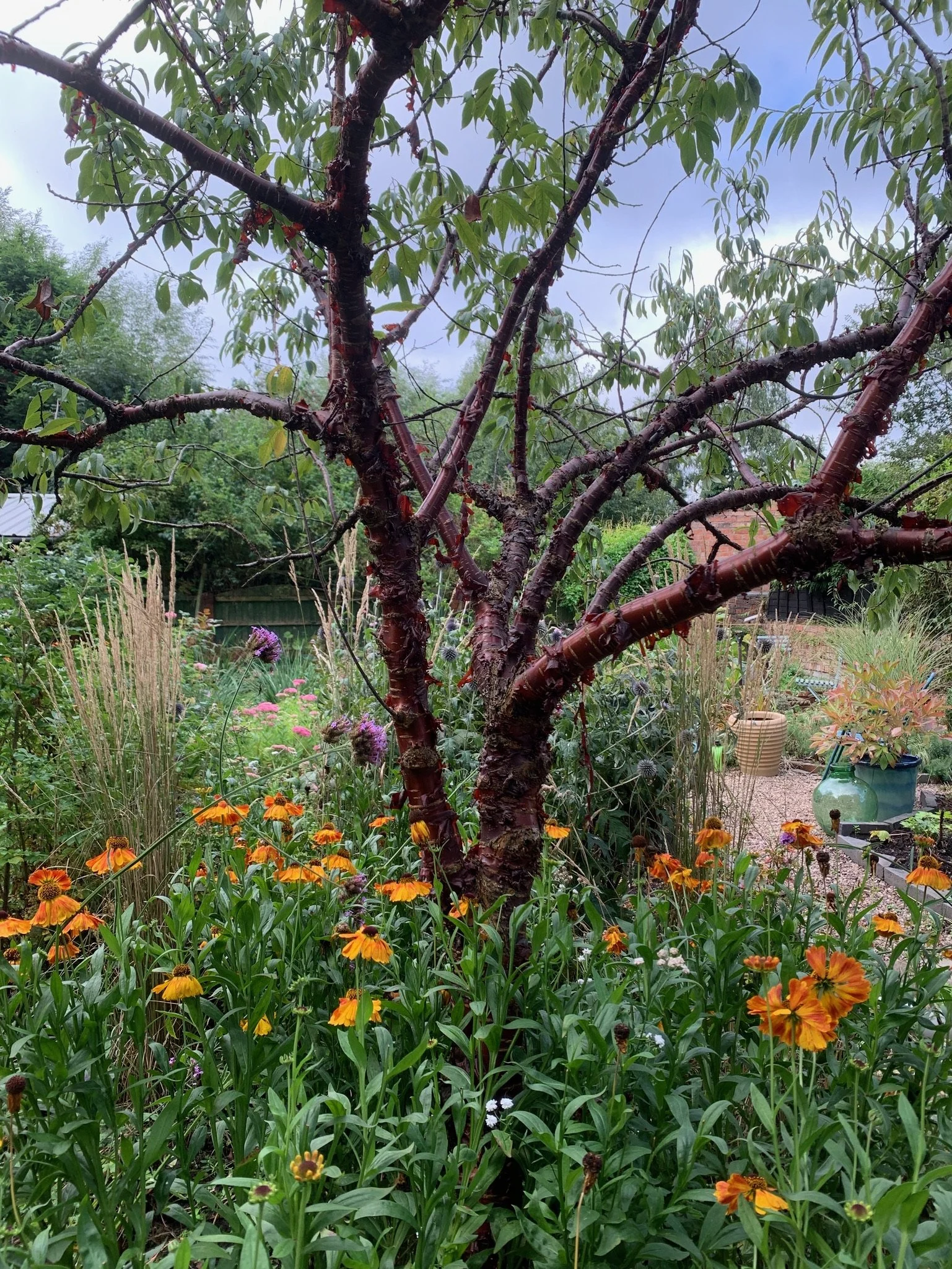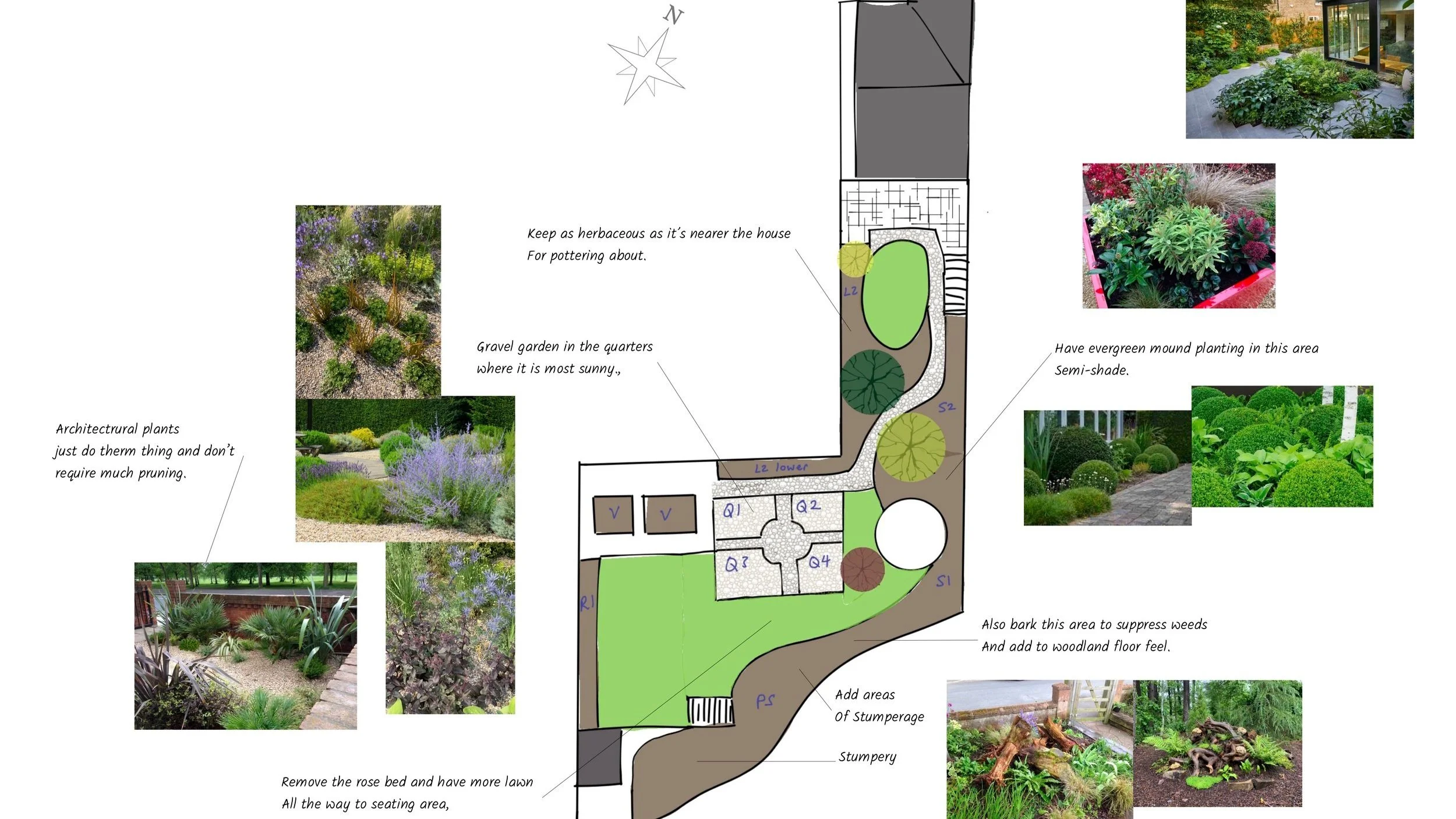Case Study - An established garden adapting to climate change. Part 1: - the context
This beautiful garden has been lovingly created over 20 years by its owners… my parents… so I’m biased. My mum designed it and together with my dad transformed it from a slightly slopey, L-shaped field into their dream space. Over the years they have filled it with plants and trees, and working with the lie of the land and incorporating reclaiming bricks and other materials found onsite they have created something really very special.
They are in their 70’s now, and whilst still pretty fit, they are becoming to recognise not only the work involved in maintaining and keeping the garden looking good but also the demands that climate change is increasingly having on it… and in fact the demands that the garden itself has on the climate.
Climate change means that we are starting to see extremely hot weather and prolonged periods of drought. As well as flooding when the parched ground cannot soak up the water when it does rain and there being more and more hard surfaces and concreted front gardens. Hosepipe bans means that they cannot water the plants that really need it. This makes it even more important to think of ways to save and harvest water.
With all this in mind, my parents have asked us to look at their space with fresh eyes and design them a garden with a focus on what plants they have, whether they are the right plants to keep, what they could add to be more drought tolerant and also be lower maintenance.
The current space is what you would call a cottage garden with informal, curved planting spaces, rustic materials like bricks and gravel and old natural stone paving slabs . The plants they have are ones that have lots of flowers, they spread around and intermingle with each other, like hardy geraniums. The plants also ‘self seed’ which means that once a flower has gone past its best, it becomes a cluster of seeds that will drop to the ground and germinate; meaning lots of new plants spring up where they land. There are also alot of perennial plants. What is a perennial plant? These are generally flowering plants that come back year after year, often they die back in the winter and disappear altogether, then sprout new growth in the spring. The maintenance of these sorts of plants is quite high in that they need cutting back and dead vegetation clearing away and disposing of. To keep flowers comng on many plants, the old flower heads must be snipped off; a process called ‘dead-heading’ which my mum actually loves doing. Perennial plants can be tall and floppy, which means they need propping up or staking, when plants get too big they lose their vigour or outgrow their space and need dividing, which is when you have to dig up the whole clump and chop it or break it into smaller plants to be planted elsewhere. Many perennial plants need alot of water to keep thriving through the year.
The Garden consultation process
Firstly we had a good chat with the clients to understand how they felt their garden was working for them and also not working for them. We asked about which plants did well in the summer heat and which didn’t. Also to find out which plants they really love and that they don’t want to lose.
We took some soil samples and measurements to understand the conditions. We took notes of where the sun came into the garden and where the shady areas are. We then made an inventory of the plants in the garden for the purpose of analysing their position and making sure the ‘Right Plant is in the Right Place.’
What is Right Plant, Right Place?
This is the idea that if you grow a plant in an environment that provides its preferred conditions, the plant stands a much better chance of thriving. So growing your plants in the right place is the most important thing you can do to keep them happy and grow well and flourish. Each plant species and variety has particular conditions that they love. ‘Conditions’, are a variety of things including the amount of sun they want, the air and ground temperature they prefer, the amount of water they need, and the level of nutrition.
Look at this time-lapse video of an Astilbe in my parent’s garden in the summer. The poor thing was completely droopy and sad looking. Two watering cans of water poured onto the soil around it and this is what happened. Look at the plants in the foreground following the path of the sun to get as much light as they can.
So back to my parent’s project…
Map taken from the Soilscape database from Cranfield University
The garden is on the apex of three different soil types as shown in the image. As well as having a stream at the bottom of the garden; outside the boundary but nevertheless it has been known to flood into the garden.
The soil taken from the garden was Sandy Loam in some areas and Loamy Sand in others. Any soil with Loam in is very welcome, as it has a lovely mix of sand, clay, and silt which is the perfect growing medium.
The garden also has several areas of shade and other areas in full sun.
Back in the office, we started going through the plants and grouping them according to the brief. The groups were as follows; are they drought tolerant, are they low maintenance,… and then do we leave them where they are, move them to another part of the garden or remove them entirely.
Drought tolerant plants
Plants that did well during the heat in their garden were
Hosta’s,
Hellebores,
Grasses,
Begenia,
Helleniums,
hydrangea and
euphorbia.
Plants in the inventory which are supposed to be happy in the sun and drought;
Verbena bonariensis
Lavender
Sedum
Echinops
Acanthus
Poppies
Our main criteria for taking out plants was whether they are invasive (getting too big for their boots), self-seeding or requiring a lot of maintenance. In this garden these included;
kniphophia
lambs ears
alchemilla mollis
Creating a garden you truly want to be in is a journey of creativity, care, and connection to your outdoor space. Whether you have a sprawling backyard or a cosy courtyard, thoughtful design can transform it into a sanctuary that reflects your personality and lifestyle. At Jo Hobbs Garden Design, we believe every garden deserves to be a place of joy and relaxation at whatever stage of life you are– tailored to you and the environment around you. Let’s work together to bring your vision to life, crafting a garden that feels like a natural extension of your home and a haven you’ll love spending time in.




